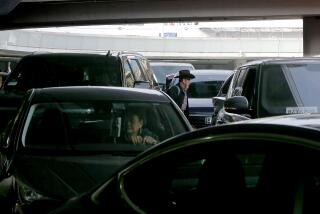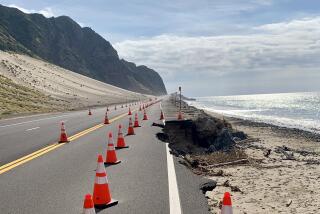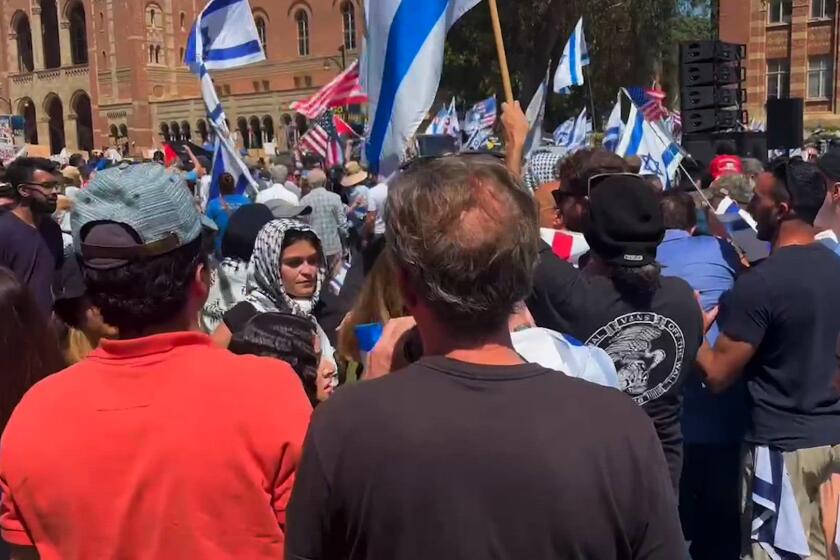In the Carmageddon drama, L.A. drivers had to know their roles
The shutdown of the 405 is a story that can be told in numbers: 500,000 drivers, 53 hours, 10 miles and eight words.
Plan ahead. Avoid the area, or stay home.
As a slogan, it hardly has the stirring eloquence of Madison Avenue behind it. Dutiful, plain-wrapped and direct, it has become over the last two months the bureaucratic catch-phrase for the closure, and its formulation — and dissemination — captures the difficulty of delivering an effective message to a region intent upon its travels.
Since first breaking ground on May 8, 2009, the I-405 Sepulveda Pass Improvements Project — as the 10-miles of construction from the 10 to the 101 freeways is officially called — has kept public relations officers busy at the Metropolitan Transportation Authority, which is in charge of the work.
PHOTOS: ‘Carmageddon’ closes the 405 Freeway
Cloverleafs jammed with cars. Traffic lanes were cordoned off as machinery ripped at hillsides to anchor new embankments. The bridges at Sunset Boulevard and Skirball Center Drive were partly rebuilt. Short-term pain for long-term gain was the justification, especially as the MTA braced itself for the biggest demolition job of all: the Mulholland Drive bridge. Fifty-three hours — the duration of the closure — can not pass quickly enough.
What the geology of Southern California — the Santa Monica Mountains and the Hollywood Hills — has torn apart, three freeways have knit together: the 405, the 101 and the 5. To close one is to clog the others.
Traffic engineers have estimated that 500,000 drivers — the number of those who typically use the Sepulveda Pass over a summer weekend — need to stay away or stay home in order for this weekend’s traffic not to slow to a crawl on the adjacent freeways.
The best-case scenario has drivers’ respecting the official plea and the work ending before the Monday morning rush hour. The worst-case scenario has work crews falling behind schedule and drivers flouting the warning.
Doug Failing, MTA’s executive director of highway programs, can imagine bumper-to-bumper congestion extending into Pasadena and possibly South L.A.
The closure, he said, “is not just a Westside message. It’s really the entire Los Angeles system.” With the 101 and the 5 as alternate routes, the traffic that goes through the Sepulveda Pass, he said, “has to concentrate near downtown Los Angeles or downtown Pasadena.”
Delivering that message depended upon a roomful of public information officers representing various agencies from the region, who gathered last May in Elysian Park. They knew they needed to get ahead of the story.
The closure had already been reported on the website of county supervisor Zev Yaroslavsky. “Los Angeles,” proclaimed Zev’s Blog, “you’ve already lived through plenty…. Well, you ain’t seen nothing yet.” Two days later, the Daily Breeze described the shutdown as “a midsummer weekend’s nightmare.”
Although fear worked to the planners’ advantage, a broader message needed to be crafted that would allay anxieties, answer questions and reach a fragmented media market in a city that was linked mostly by distraction and indifference.
Before the media specialists began their work, however, Kirk Albanese, deputy chief with the Los Angeles Police Department, needed to express his concerns.
For law enforcement agencies, the closure has always been a matter of public safety. If somebody has a heart attack in one of the canyons, could emergency services get them to UCLA within six minutes? If somebody is the victim of a gunshot or in a traffic accident, could they be helped?
Albanese had to make it clear: Drivers who don’t have critical business in the area must stay away.
The first task was to issue a news release announcing the dates of closure and relaying the urgency.
An early draft laid out the reasons — the widening of the freeway, the addition of a carpool lane — but some felt that approach was too complicated. A sound bite was needed, so a slogan was drafted: “Stay away. Don’t drive. Stay home.”
Over the next day — in conference calls and in meetings — the public information officers debated the language. Some felt the slogan was too forbidding. Just because a freeway closes down, the city doesn’t have to.
The initial phrase, said Nancy Castles with Los Angeles World Airports, sounded like the city was “pulling the welcome mat and putting up a sign that Los Angeles is closed for business.”
The words evolved to “Plan ahead. Avoid the area.” Further debate focused on a public transportation component — “ride the rails” or “share a ride.”
“Stay home” eventually won. “Plan ahead. Avoid the area, or stay home” opened the May 27 news release. Media interest in the story took off.
“Our universe exploded,” said Marc Littman, MTA spokesman. “It’s like the Big Bang. That initial May 27 press release went viral.”
“Carmageddon” entered the local lexicon. The word had been the name of a video game, but when applied to the closure, it stuck. Google “Carmageddon 405” today and more than 2.5 million results appear — and the number is steadily increasing.
The MTA said it spent $100,000 in advertising to announce the shutdown in print and radio and on websites. In addition, the news was carried in email blasts, newsletters, social media sites, celebrity tweets and message signs on city streets and freeways.
One organization has been tweeting for 10 days a list of 45 “fun and iconic things to do in Los Angeles … without a car.” A website has offered “53 ways to survive without the 405,” and in Santa Monica, a “Host a Farmer” program asked residents to house farmers to make sure they make it to the Saturday and Sunday markets.
If reaction to the closure has seemed at times hyperbolic, the slogan was intended to rein in the drama. For a city that often imagines the worse for itself in its movies and books, the closure is an appeal to civic responsibility.
“We live together. We are a society,” Failing said. “We do not live as isolationists on our own little island.”
More to Read
Start your day right
Sign up for Essential California for news, features and recommendations from the L.A. Times and beyond in your inbox six days a week.
You may occasionally receive promotional content from the Los Angeles Times.







